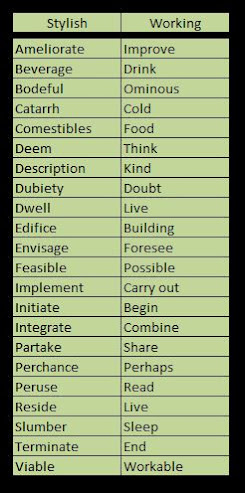Lunch (pronounced luhnch)
(1) A light midday meal between breakfast and dinner; luncheon.
(2) Any light meal or snack.
(3) To eat lunch.
(4) In slang, as “out to lunch”, dim, vague, uselessly ineffectual.
(5) In slang as “lunchy”, old-fashioned; passé; out of style (obsolete).
(6) In slang as “eating their lunch”, outwitting an opponent.
(7) In Caribbean slang (among older folk), mid afternoon tea.
(8) In first-class cricket, the break in play between the first and second sessions (confusingly for those new to cricket, although the first session is often called the "pre-lunch session", the second is known as the "lunch session" and not the "post lunch session").
(9) In Minnesota, USA, any small meal, especially one eaten at a social gathering.
1580: It’s never been clear which came first: lunch or luncheon. Origin of both is thought to lie in a dissimilated variant of nuncheon, the Middle English nonechenche (noon ling meal and drink), equivalent to none (noon) + schench (from the Old English scenc or scencan (to pour out, give drink)), cognate with the Dutch and German schenken. Apparent unrelated, Old English had nonmete (afternoon meal, literally "noon-meat"). Nonechenche was possibly altered by the northern English dialect lunch (hunk of bread or cheese) from 1590 which may be from lump or the Spanish lonja (slice, literally “loin”). Because dinner in the sense of the biggest or main meal of the day) could be eaten either at around noon, in the evening or at night, there was a need for a meal to fill the gap between breakfast and dinner. Lunch is a noun & verb, luncher is a noun, lunching is a noun & verb and lunched is a verb; the noun plural is lunches.
A montage of a languid Lindsay Lohan lingering over lunch.
The idea of lunch as it’s now understood took a long time to evolve, to “take a lunch” in 1786 is recorded as eating a chunk of something (perhaps evolved from lump), carved sufficiently large to constitute a filling meal and as late as 1817, the US Webster’s Dictionary offered as the only definition of lunch "a large piece of food", a meaning long obsolete and in the 1820s, the Oxford English Dictionary (OED) thought it either “a vulgarism or a fashionable affectation". Nevertheless, lunch’s intrusion into the language in the nineteenth century does suggest some sort of social change was afoot, either in the type, style or timing of meals or at least the words used to describe them. Lunch-money was attested from 1868; lunch-time from 1821; lunch hour from 1840 and the lunch-break from 1960. The slang phrase out to lunch in the sense of “a bit vague, dim, clueless (but some way short of actually insane) was first recorded in recorded 1955, the notion of being "not there" and instead at lunch. The luncheon voucher was a public health measure, introduced in 1946 by the UK’s post-war Labour government (1945-1951). It was literally a paper voucher which represented the mechanism by which the government would subsidize midday meals taken in private restaurants by employees in workplaces where there was no staff canteen. Luncheon vouchers were an attempt to improve the national diet by encouraging the consumption of healthy, nutritious food at a time when so many basic items were still subject to the rationing imposed during wartime (indeed, some foodstuffs were subject to rationing only after the conflict ceased). In an example of bureaucratic inertia, the scheme existed to an extent until 2013 by which time the effects of inflation had made the by then trivial subsidy inconsequential.
Receptacles in which to store one’s lunch for transport have a history. The lunch-box is documented from 1864, the lunch-pail from 1891. Those were descriptive nouns whereas lunch-bucket emerged in the 1990s as an adjective indicating working-class men or values, bucket presumably the best word because it was universally understood in the English-speaking world to an extent pail was not. Lunch-bag seems never to have become a common form despite being widely used but in the 1970s, the verb brown-bag (and the related brown-bagging) referring to bringing lunch or liquor in a brown paper bag. A long-time staple of a lunch-pail’s contents, lunch-meat (a processed form of meat-based protein produced in a size which, when sliced, was aligned with the slices of standard loaves of bread and thus convenient for making sandwiches) was first documented in 1931. The lunch-counter (a long, elevated table or bench where customers eat standing or sitting on high stools) is an 1854 invention of US English.
The portmanteau word brunch dates from circa 1890, a British student slang merging of breakfast and lunch, according to the magazine Punch (1 August 1896). It appeared in 1895 in the defunct Hunter's Weekly, but two years earlier, at the University of Oxford, the students had drawn what must at the time have seemed an important distinction: The combination-meal, when nearer the usual breakfast hour, is "brunch" and, when nearer luncheon, is "blunch". That’s a linguistic curiosity in that the brunch survived while blunch did not yet the modern understanding of a brunch appears to be something taken closer to the time of lunch than breakfast. It may be that brunch was just the more pleasingly attractive word, blunch not so well rolling off the tongue. Several spellings of luncheon were noted in the decades after the 1640s, the now standardised form not widespread until 1706. Of uncertain origin, in the 1580s was used to describe something like the northern English dialectal lunch (hunk of bread or cheese), though influenced by the Spanish lonja (a slice, literally "loin"), blended with or influenced by nuncheon, from the mid-fourteenth century Middle English nonechenche, (light mid-day meal), from none (noon) + schench (drink), from the Old English scenc, from scencan (pour out).
The etymology of all these words is tangled and there are reasons to suspect the similar forms arose independently in different place rather than as forks of anything vaguely lineal, the OED discounting the notion of lunching, which dates from the 1650s, being derived from the verb lunch because that wasn’t to be attested for another century, the OED suggesting there may be some connection (by analogy) with words like truncheon etc to simulate a French origin which is speculative but such things are not unknown in ever class-conscious England. Whatever the origin, it does seem to have been used to describe an early afternoon meal eaten by those who take dinner at noon.


















